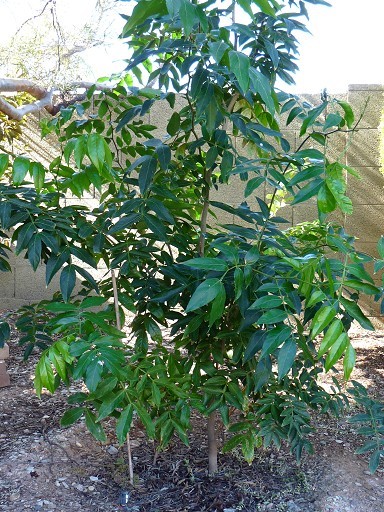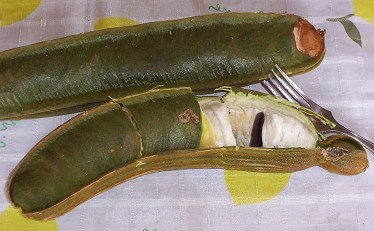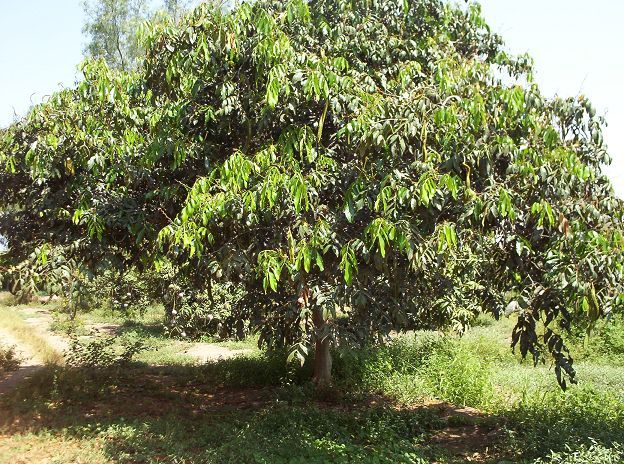|
 Photo
Photo
The 3 foot pacay tree on the right was photographed in late November. It is approximately
5 years old, and has been in the ground for 3 years. It was grown from a seed
and was originally kept as a potted plant. Pacay seeds tend to sprout in the ripe fruit, so
planting this tree was more like planting a small seedling than planting a seed.
I was unsure whether this tree would need cross pollination to fruit so I planted two trees
very close to one another. The second tree is also present in the picture but it has grown
much more slowly.
This plant is located in a filtered shade location on the north end of a peppermint
eucalyptus tree. The shade there is only very lightly filtered and alternates with full
sun.
During its first year in the ground it was scraggly, sparsely foliated,
and generally slow growing. However, as it becomes more established it is dramatically picking up speed
and has more than doubled in size in the last year.
This tree has not yet fruited, but did produce a couple of flowers last spring.
Pacay is reported to be slightly more hardy than its cousin the ice cream bean (Inga edulis),
but to be on the safe side the lower part of this tree is covered with a frost cloth on nights when
there is a frost warning.
Overview
Pacay trees are native to the coastal river valleys of Peru.
The climate in this region, being just beyond the cool marine influence,
is generally warm to hot and humid all year round.
Pacay is a legume, meaning it is a relative of green beans, snap peas, alfalfa,
lentils, and peanuts etc.
Being in this family, it bears an unusual fruit for a tree
that resembles a giant bean pod, with a sweet, refreshing, cotton like
edible fiber on the inside. Like its legume relatives pacay is
nitrogen fixing, meaning it actually adds nitrogen to the soil rather than taking it away.
The desert heat of Arizona doesn't appear to bother the plant very much, but
the dry air is more hard on it. Given a good microclimate and sufficient water,
Pacay grows steadily in Phoenix. The biggest threat to pacay is temperatures
below freezing in the winter.
 Fruit
Fruit
The pacay fruits on the left were purchased from a fruit stand in Casma, Peru.
They are naturally perfectly packaged for sale, in large bean like pods. To eat
them one has to break them like snapping a stick, which is relatively easy, and
then peal back the sides. The edible wedges, viewable in the photo, can then
be taken out one by one and eaten. Each wedge contains a seed which separates
cleanly from the fiber around it. Seeds are not eaten and are dark black and
glossy, and are often already sprouting in the ripe fruit.
Pacay fruit is delicious. It is light and refreshing, with a hint of vanilla, and a mildly sweet
flavor. It appears to a very perishable fruit, so maybe this is why it is completely unknown in
the rest of the world, because it is definitely the type of flavor that is universally appealing.
Heat Tolerance and Sun Exposure
Pacay trees grow well in filtered shade in Phoenix, and they would also most
likely do well in afternoon shade. Full sun in the driest
months of summer is too harsh for them, because they come from a humid climate.
The monsoon summer months are better suited to pacay, and they are less bothered
by the heat when it is combined with humidity.
Cold Tolerance
Pacay trees starting being damaged at 29 F., so precautions should be taken
to protect them on the handful of winter nights that get close to this mark. Frost cloth
and potentially a source of heat can be used to ensure ones tree makes it through the night.
When a tree is young, a support for the frost cloth will be necessary, such as a simple
tent made out of lawn chairs.
Planting
Dig a hole at least twice the size of the rootball. At a minimum, make the
hole 2 feet in diameter and 2 feet deep.
Back fill the whole with the same native soil that was removed.
It also is a good idea to finish with the
hole an inch or two recessed so that a watering basin is formed.
After planting, spread a thin layer of compost on top
of the soil to help conserve moisture and to supply some nutrients.
Do not fertilize the newly planted tree until it has been vigorously growing for
a couple of months.
Watering frequency
Pacay does well on a grass watering schedule.
Watering method
Basin irrigation
is recommended because it helps keep the salt in our salty
water from accumulating around the roots. Furthermore, deep watering
will encourage the plant to develop deeper roots, making the plant tougher when the weather
gets hot and dry.
Pacay Tree (Inga Feuillei) at the Sechin Museum, in Casma, Peru

Fertilizing and Growth Rate
Since pacay is a nitrogen fixing legume it does not
need any nitrogen fertilizer. In fact, it does seem to burn very easily, so nitrogen
fertilizers, especially chemical ones, should be avoided. Pacay trees are especially hungry for
potassium, frequently showing signs of potassium deficiency.
To keep a Pacay healthy, apply applications of a fish emulsion based 0-10-10 fertilizer during warm and hot weather every couple of months.
Pacays also sometimes show signs of magnesium deficiency,
in Phoenix soils, and are therefore prone to primature leave drop.
So magnesium, in the form of magnesium sulfate, can benefit pacay plants here.
To apply magnesium sulfate, mix a three fingered pinch of agricultural grade powder
in a gallon of water and pour on the soil around the drip
line of the plant. Do this a couple times during warm and hot weather if it appears the plant needs it.
Some sources on the internet state that applying potassium to a plant can inhibit the uptake
of magnesium. So, it is interesting that I have found the combination of potassium and magnesium amendments
to be affective in keeping a pacay healthy.
When my pacay shows yellow leaves with tip burn and very little growth and none of the other amendments listed above seem
to help, I have seen miraculous results by treating it for iron and zinc deficiency. My favorite product for this is
Liquinox Iron and Zinc
diluted at a rate of about 4 oz in a gallon of water.
Propagation
Pacay is grown from seed.
Pests
No known pests in Phoenix Arizona.
Links to more pacay information
Pacay - Lost Crops of the Incas
Pacay - Wikipedia
|
 Book the Phoenix Tropicals Condo on Kiahuna Beach, in Kauai, Hawaii
Book the Phoenix Tropicals Condo on Kiahuna Beach, in Kauai, Hawaii